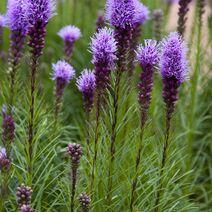Liatris spicata
| Liatris spicata | |
 | |
| Light: | |
| Moisture: | |
| Hardiness: | 3 |
| Soil pH: | 5.6-8.4 |
| Height: | 2' |
| Width: | 1' |
| Blooms: | Early Fall |
| Native to: | |
| Shelter Nectary | |
| Medicinal Rating: | |
| Tea: | Yes |
Liatris spicata (common names: gayfeather, marsh blazing star, and dense gayfeather)
Propagation: Seed - best sown as soon as it is ripe in autumn in a greenhouse[1]. Sow stored seed as soon as possible in the year in a greenhouse. Prick out the seedlings into individual pots when they are large enough to handle and grow the plants on in the greenhouse for their first year. Plant them out into their permanent positions in early summer.
Division in spring[2]. Larger clumps can be replanted direct into their permanent positions, though it is best to pot up smaller clumps and grow them on in a cold frame until they are rooting well. Plant them out in the spring.
Basal cuttings taken in spring as growth commences. Harvest the shoots when they are about 10cm long with plenty of underground stem. Pot them up into individual pots and keep them in light shade in a cold frame or greenhouse until they are rooting well. Plant them out in the summer.
Cultivation: Grows well in a moderately good light soil[2]. Requires a moist to wet position[2][1][3]. Established plants are very drought tolerant so long as there is plenty of humus in the soil[4]. Prefers a sunny position[5] but succeeds in shade[6].
Plants are hardy to about -25°c[7].
The plant has an agreeable odour, due to the presence of coumarins[8].
A good bee plant[2].
Rodents are very fond of the tubers so the plants may require some protection[1]. Slugs are fond of the young shoots in spring[3].
Range: Eastern N. America - Pennsylvania and New Jersey to Wisconsin, south to Florida and Louisiana.
Habitat: Meadows, borders of marshes, savannahs, damp slopes etc[9]. Poor dry ridges[4].
Medicinal: The leaves and root are anodyne, antibacterial, astringent, carminative, diaphoretic, diuretic, emmenagogue, expectorant, stimulant and tonic[8][10][11][3][12]. The plant is said to be extremely efficacious when used as a local application in the treatment of sore throats and gonorrhoea[8]. It is also used in treating kidney diseases[3]. The leaves are harvested in the summer, the roots in the autumn. Both can be used fresh or dried[3].
Usage: The aromatic leaves and roots are added to pot-pourri[3].
The leaves and the roots are added to various insect-repellent herbal mixtures[3].
Pollinators: Bees
Soil: Can grow in light and medium soils.
Drainage: Prefers well drained soil.
Seed Ripens: Mid Fall
Flower Type: Hermaphrodite
Known Hazards: Although we have no records of toxicity for this plant, one record says that the leaves contain coumarins. These have an anti-clotting effect on the blood and can prevent natural clotting of the blood when there is a cut[K].
Links
References
- ↑ 1.0 1.1 1.2 Huxley, Anthony. The New Royal Horticultural Society Dictionary of Gardening. MacMillan Press, 1992.
- ↑ 2.0 2.1 2.2 2.3 Chittendon, Fred. RHS Dictionary of Plants. Oxford University Press, 1951.
- ↑ 3.0 3.1 3.2 3.3 3.4 3.5 3.6 Bown, Deni. Royal Horticultural Society Encyclopaedia of Herbs and Their Uses. Dorling Kindersley, 1995.
- ↑ 4.0 4.1 Chatto, Beth. The Damp Garden. Dent, 1982.
- ↑ International Bee Research Association. Garden Plants Valuable to Bees. International Bee Research Association, 1981.
- ↑ Sanders, Thomas. Popular Hardy Perennials. Collingridge, 1926.
- ↑ Phillips, Roger and Martyn Rix. Perennials - The Definitve Reference. Pan Books, 1991.
- ↑ 8.0 8.1 8.2 Grieve, Margaret. A Modern Herbal. Penguin, 1984.
- ↑ Lyndon, Merritt. Gray's Manual of Botany. American Book Co, 1950.
- ↑ Lust, John. The Herb Book. Bantam Books, 1983.
- ↑ Coon, Nelson. The Dictionary of Useful Plants. Rodale Press, 1975.
- ↑ Moerman, Daniel. Native American Ethnobotany. Timber Press, 1998.